Lammeröfen
Lammerklamm
Useful Information
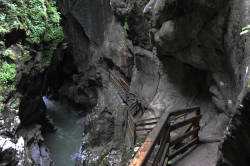
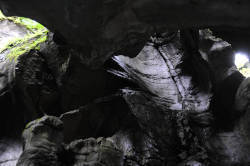
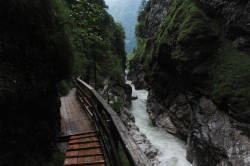
| Location: |
Oberscheffau.
Highway from Golling to Abtenau, Lammertalstraße (B162).
Signposted.
Lower Entrance: Restaurant Lammerklause, Oberscheffau. Upper Entrance: parking lot at highway B162. (47.587819, 13.269271) |
| Open: |
MAY to OCT daily 9-18. [2021] |
| Fee: |
Adults EUR 3, Children (6-15) EUR 1.50, Children (0-5) free. Family Ticket: Adults EUR 2, Children (6-15) EUR 1. Groups (15+): Adults EUR 2.50. [2021] |
| Classification: |
 Gorge Gorge
|
| Light: | n/a |
| Dimension: | L=1000 m, VR=43 m. |
| Guided tours: | self guided, D=30 min one way. Dunkle Klamm: D=30 min. |
| Photography: | allowed |
| Accessibility: | no |
| Bibliography: | |
| Address: |
Tourismusbüro Scheffau, Scheffau 50, 5440 Scheffau am Tennengebirge,Tel: +43-6244-844220.
E-mail: |
| As far as we know this information was accurate when it was published (see years in brackets), but may have changed since then. Please check rates and details directly with the companies in question if you need more recent info. |
|
History
| 1884 | trail through the gorge built. |
| 1920 | end of timber transports. |
| 1978 | declared a Naturdenkmal (Natural Monument). |
Description
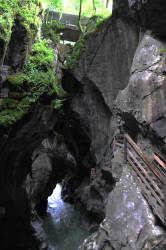
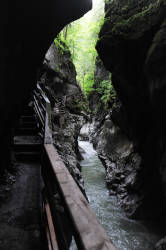
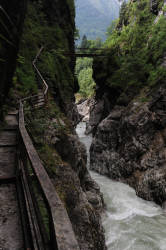
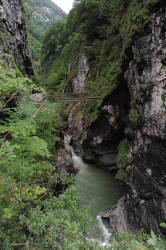
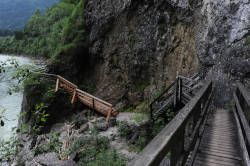
The Lammeröfen is a gorge created by the Lammer river.
It is not called Klamm, which is the Austrian term for narrow gorge, because Öfen (ovens) is a local term for round gullies and
 potholes
the water creates.
So several gorges in the area have the ending -öfen instead.
However, recently the name Lammerklamm is used to make it easier for tourists.
potholes
the water creates.
So several gorges in the area have the ending -öfen instead.
However, recently the name Lammerklamm is used to make it easier for tourists.
The Lammer is a right tributary of the Salzach river, which only a few kilometer to the north is the wide green stream you probably know from postcards of Salzburg. The valley is blocked by a massive limestone mountain and the Lammer has cut a narrow gorge through this mountain. The road also crosses the mountain but high above the gorge on the hillside. At the upper end there is the ticket office, and a trail leads down into the most spectacular part of the gorge. Another trail follows the main gorge downstream to the village Oberscheffau. It’s also possible to start at the Restaurant Lammerklause in Oberscheffau and walk the gorge upstream, which is more spectacular. In this case you pay the ticket when you leave the gorge at the upper end. If you do not want to return on the same track you should organize pickup. Some years aco you could also take the bus, there are bus stops at both ends, but the bus line was unfortunately closed.
At this point we have to explain the basics about the tickets, because international tourists often have the idea that this gorge is an enterprise operated by a company. The gorges in Austria are normally operated by a non-profit association, often by the mountaineering club, or by the municipality. They repair the trails every year with a great effort. The tickets are a sort of donation to finance this work, because even when the volunteers work for free, there are costs for material and tools. Many gorges only have a box where you throw the fee in. Some, like this, have a kiosk, which is primarily for selling snacks and beverages to the visitors, offering toilets, and they also collect the entrance fee. So while it is usually possible to pass by without paying, this is a blatant discourtesy and a disregard for the hard work of the volunteers.
The most impressive part of the gorge is located right at the upper entrance, and many visitors only visit this part. The Dunkle Klamm (dark gorge) is the deepes and most narrow part of the gorge. The bends in the walls make it impossible to see the sky above, and it is quite dark inside, almost like a cave, hence the name. The trail goes down into the gorge in serpentines with many steps, and at the bottom there is a footbridge across the river. You can see a bridge at the far end which crosses the gorge high above. This is actually a road bridge and cars use it to get to the second parking lot on the other side of the gorge. Because the gorge is only a few meters wide, a tiny bridge is sufficient. At the narrowest point the walls are only 1 m apart! This trail is a dead end, and you have to return to the kiosk, where the other trail down the gorge starts.
The upper part of the valley is V shaped, and was formed before the last cold age. At the end of the last ice age the enormous amounts of melting water were flowing down the V shaped valley, cutting fast and deep into the limestones. After only a few thousand years the gorge was formed in its current form. So it is quite young and probably short-lived.
The area around the gorge is forested, and wood was needed to build the tunnels in the Hallein salt mine and as heating material for the saltworks. Salt was the white gold of the region, and the mines paid well for the wood. Since the Middle Ages rivers were used to float timbers to the customers, a simple method to transport them. It was called Trift (float), and was rather simple in wide, deep and slow flowing rivers. It was extremely dangerous in the narrow gorges. Sometimes when the water level was too low, it was even necessary to dam the river to flush the wood through. There was a danger of blockages, and unblocking them was particularly dangerous because the logs could snap back unexpectedly, often resulting in serious injury and death. In order to enable the lumberjacks to loosen blockades in the gorge, Triftsteige (float trails) were hewn into the walls of the gorge. However, these were hardly comparable to today’s paths and were very dangerous. From 1884 when the tourist trail was built, at least the trails were safer. The gorge was used for wood transport until 1920.
Beneath the walking tour through the gorge, there is also the possibility to book guided tours with canoe, rafting boats or tubes. In this case the gear is provided. For the walk through the gorge good walking shoes are required. Avoid standing on the bridges in groups should be avoided. Avoid throwing anything into the gorge because it could hit the canoe or raft riders.
 Search DuckDuckGo for "Lammeröfen"
Search DuckDuckGo for "Lammeröfen" Google Earth Placemark
Google Earth Placemark Lammeröfen
Lammeröfen  - Wikipedia (visited: 01-AUG-2021)
- Wikipedia (visited: 01-AUG-2021) Naturgenuss in der Lammerklamm, official website (visited: 01-AUG-2021)
Naturgenuss in der Lammerklamm, official website (visited: 01-AUG-2021) Index
Index Topics
Topics Hierarchical
Hierarchical Countries
Countries Maps
Maps